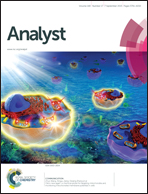Two fluorescent Schiff base sensors for Zn2+: the Zn2+/Cu2+ ion interference†
Abstract
Two simple and low cost 2,4-di-tert-butyl-6-[(1-hydroxycyclohexylmethylimino)methyl]phenol (L1) and 2-[{(1-hydroxycyclohexyl)methylimino}methyl]phenol (L2) Schiff base sensors exhibiting selectivity for Zn2+ in water : methanol (95 : 5, v/v, 10 mM HEPES) are described. L1 and L2 display an “off–on” fluorescence effect forming the L1·Zn and L2·Zn complexes, respectively. In the case of L1·Zn, the emission response is quenched by the addition of Cu2+ forming the respective L1·Cu complex; in spite of that, the fluorescence signal can be completely restored only by the addition of tartrate anions (C4H4O62−) forming again L1·Znvia the “off–on” displacement approach. However, in the case of L2·Zn no Cu2+ interference is observed, which is a typical problem for Zn2+ sensors. Here we describe that a very subtle structural change in the ligand during transition from the enol-imine tautomer in L1 to the keto-enamine tautomer in L2 is enough to modulate the Zn2+/Cu2+ selectivity. Also, the Zn2+vs. Cd2+ discrimination for L1 and L2 is proved. Moreover, we found that the interaction between both L·Zn complexes and tartrate anions completely restored the free ligands by the ligand substitution mechanism even in a more efficient association than phosphate anions. Further, a second colorimetric response channel upon addition of Fe2+ was observed for L1 and L2. Then, TD-DFT theoretical calculations were conducted in order to study the efficiency of the sensors to give different responses in the presence of such metal ions. Finally, the L2 sensor successfully detects Zn2+ in Jurkat cells cultured with and without Zn2+ enriched medium.


 Please wait while we load your content...
Please wait while we load your content...